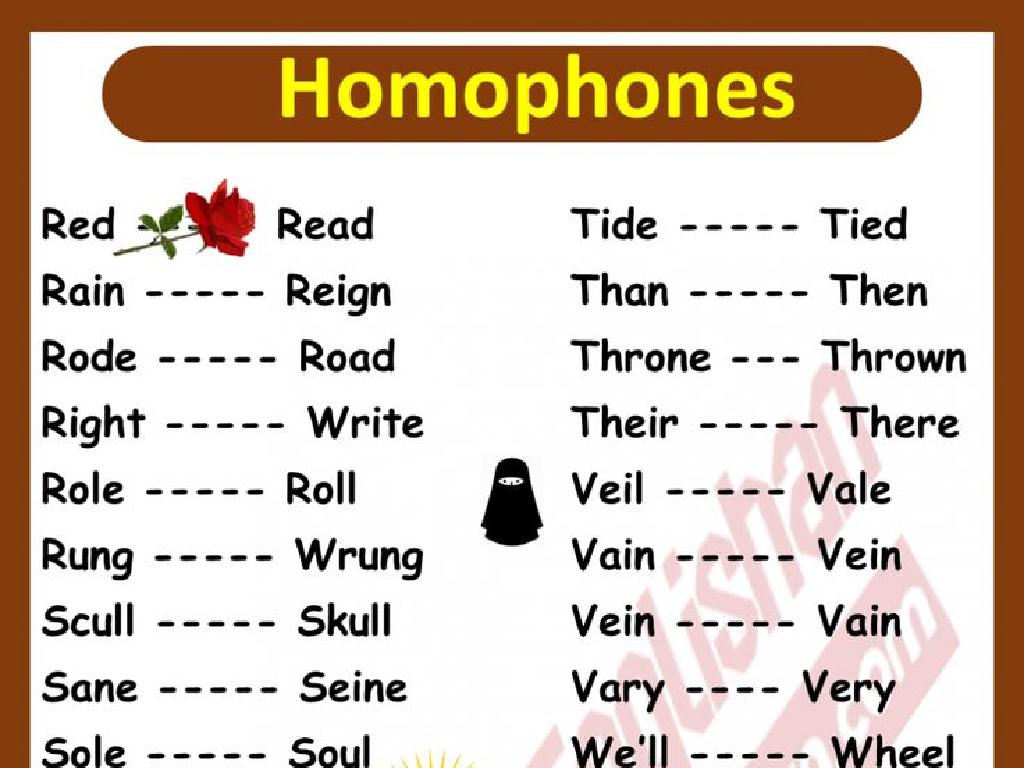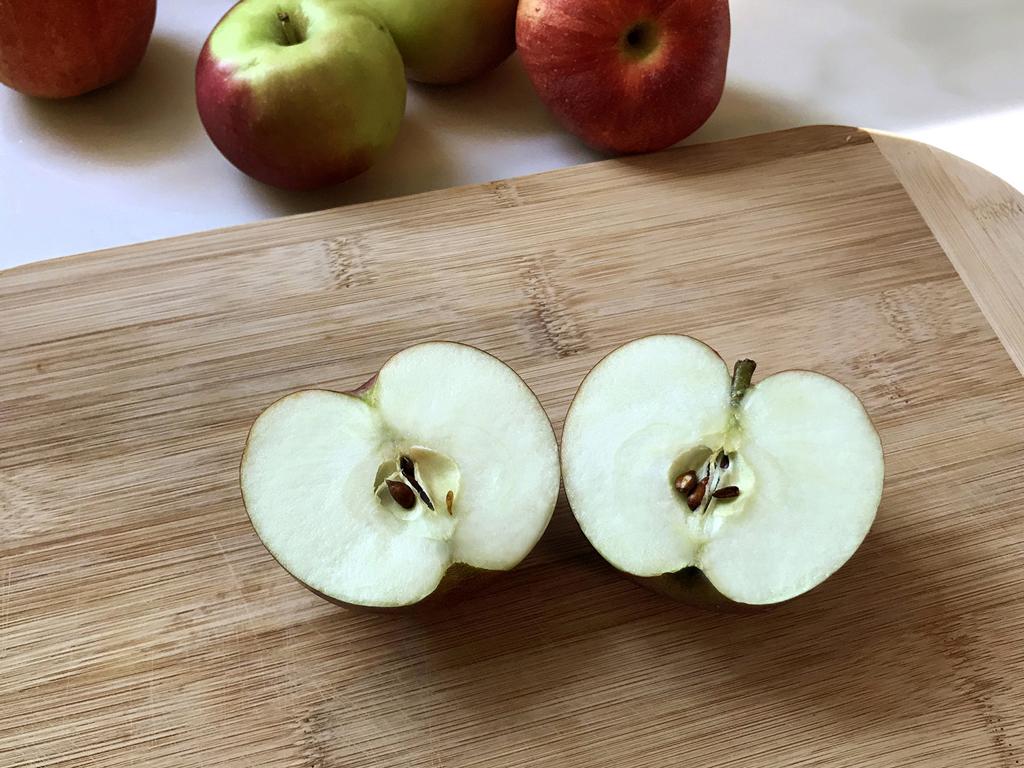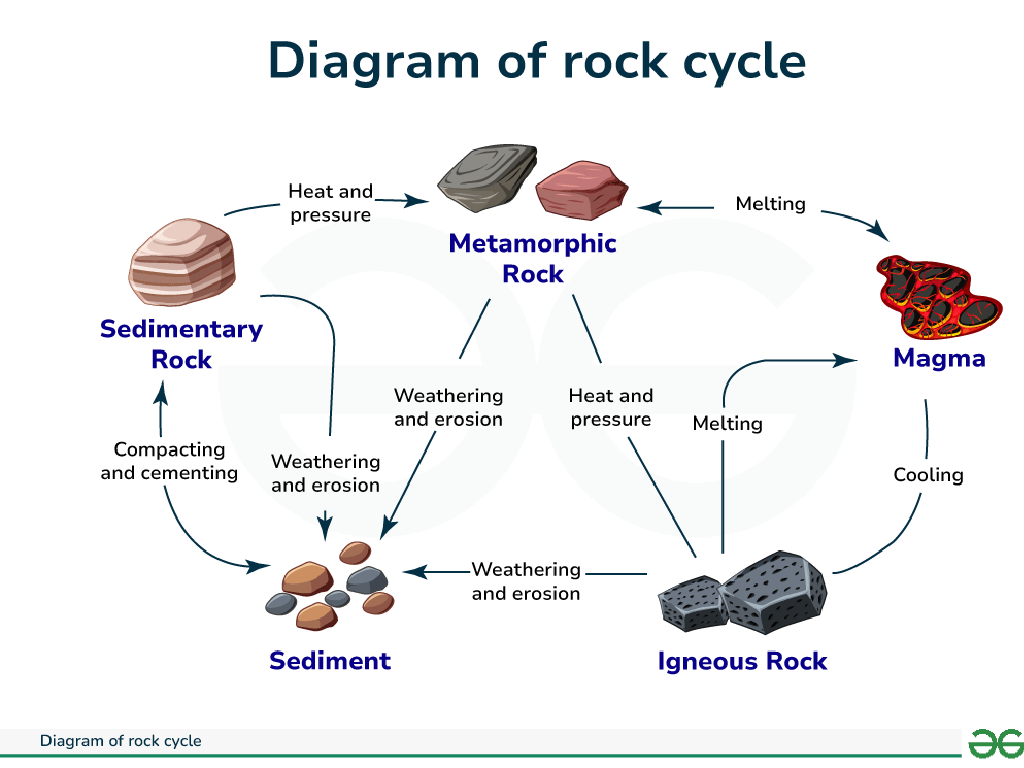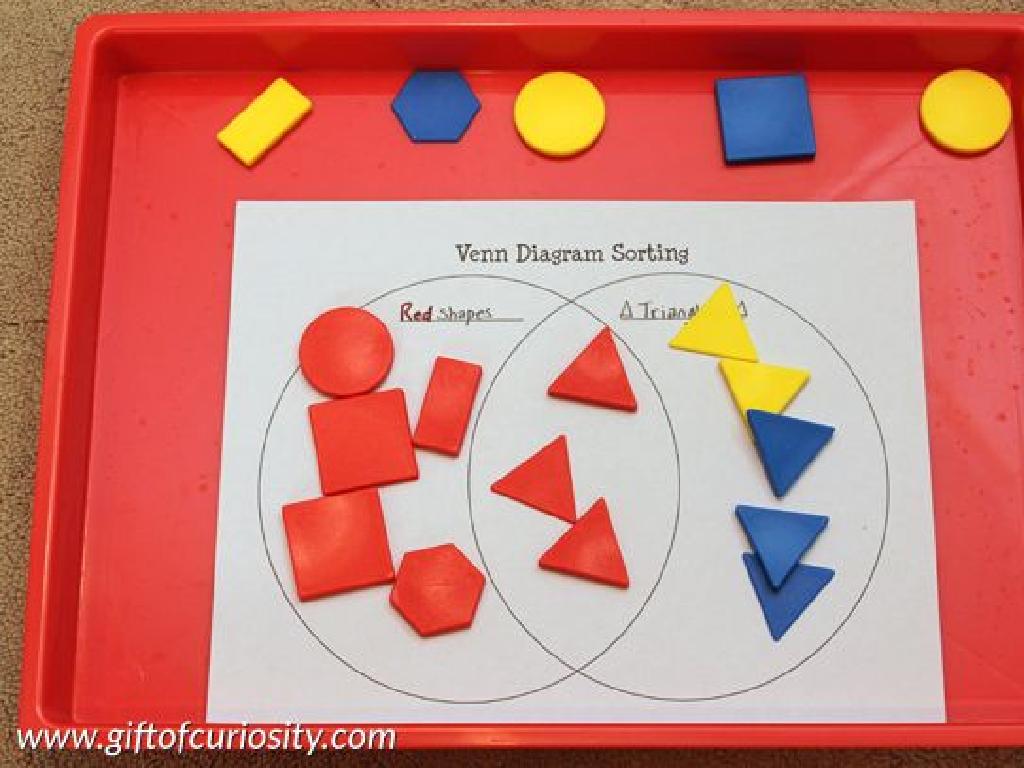Multiple-Meaning Words
Subject: Language arts
Grade: Second grade
Topic: Homophones
Please LOG IN to download the presentation. Access is available to registered users only.
View More Content
Welcome to Homophones!
– Discovering Homophones
– What are Homophones?
– Words that sound alike but are different in meaning/spelling
– Same sound, different meanings
– Example: ‘flower’ (a plant) and ‘flour’ (for baking)
– Different spellings too
– ‘To’, ‘two’, and ‘too’ sound the same but have different uses
|
This slide introduces the concept of homophones to second-grade students. Homophones are words that sound the same when spoken but have different meanings and often different spellings. Examples include ‘pair’ and ‘pear’, or ‘see’ and ‘sea’. It’s important to highlight that understanding the context in which the word is used helps us figure out the correct meaning and spelling. Encourage students to listen carefully to words and think about their meanings. Activities can include matching homophones, using them in sentences, or creating a homophones word bank. This foundational understanding will aid in their reading comprehension and vocabulary development.
Exploring Multiple-Meaning Words
– Words with multiple meanings
– Like ‘bat’ can mean a flying mammal or a baseball club.
– Context determines meaning
– Words in sentences give us clues about meaning.
– Examples of multiple-meaning words
– ‘Bark’ can be the sound a dog makes or the outer layer of a tree.
– Practice with class examples
– We’ll use sentences to figure out which ‘bark’ or ‘bat’ we mean.
|
This slide introduces the concept of multiple-meaning words, also known as homophones, to second-grade students. It’s crucial to explain that some words look and sound the same but have different meanings, and the context in which they are used can help us determine the correct meaning. Provide clear examples and engage the class with sentences that use these words in different contexts. Encourage students to think of other examples and use them in sentences. This activity will help students understand how to discern the meaning of words based on the surrounding words and how they’re used in everyday language.
Exploring Homophones
– What are homophones?
– Words that sound the same but have different meanings and spellings.
– ‘sea’ and ‘see’
– ‘sea’: a large body of salt water, ‘see’: to view with your eyes
– ‘blue’ and ‘blew’
– ‘blue’: a color, ‘blew’: past tense of blow
– Share your homophones
|
This slide is designed to engage second-grade students in the concept of homophones words that sound alike but have different meanings and spellings. Start by asking the class if they can think of any homophones, which will stimulate their thinking about language and words they already know. Provide examples like ‘sea’ and ‘see’, as well as ‘blue’ and ‘blew’, to illustrate the concept. Encourage students to share homophones they know with the class, fostering a collaborative learning environment. This activity will help students understand the diversity of the English language and the importance of context in determining word meaning.
Homophones in Sentences
– Understanding homophones usage
– Homophones sound the same but have different meanings and spellings, like ‘to’, ‘two’, and ‘too’.
– Identifying correct homophones
– Read the sentence carefully to pick the word that fits the meaning.
– Practice with sentence completion
– ‘I went ___ the store.’ Which word completes the sentence: to, two, or too?
– Reinforce learning through examples
– Use example sentences to practice choosing the right homophone.
|
This slide aims to teach students about homophones, which are words that sound alike but have different meanings and spellings. Start by explaining the concept with simple examples. Then, show how to determine the correct homophone to use in a sentence by understanding the context. Provide practice sentences for students to apply their knowledge by choosing the appropriate homophone. Encourage them to explain why they chose a particular word. This interactive approach helps solidify their understanding of homophones in a fun and engaging way.
Homophones Matching Game
– Let’s play a matching game!
– Match homophones to meanings
– Homophones sound the same but have different meanings, like ‘flower’ and ‘flour’.
– Get ready for fun and learning
– Share your matches with the class
– After matching, tell us why you paired them.
|
This slide introduces a classroom activity designed to help second-grade students understand homophones words that sound the same but have different meanings and sometimes different spellings. The game involves matching pairs of homophones with their correct meanings. For example, ‘son’ (a male child) and ‘sun’ (the star at the center of our solar system). The activity is meant to be interactive and enjoyable, reinforcing the concept of homophones in a memorable way. Teachers should prepare a list of homophone pairs and their meanings on cards for the students to match. After the game, encourage students to discuss their matches and explain the reasoning behind their choices. This will help assess their understanding and give them practice in using the words in context.
Create Your Own Homophones
– Think of a homophone pair
– Write two sentences for each
– Use each meaning in its own sentence
– Share with a classmate
– Discuss the different meanings
– Explain how the same word can have different meanings
|
This slide is designed to engage students in a creative activity to reinforce their understanding of homophones. Encourage them to think of words that sound the same but have different meanings and spellings, such as ‘flower’ and ‘flour’. They should craft two distinct sentences that clearly demonstrate the different meanings of their chosen homophones. After writing, students will pair up to share and discuss their sentences, fostering peer learning and discussion about how context changes meaning. As a teacher, facilitate the activity by providing examples and assisting students who may struggle to find or use homophones correctly. This activity not only teaches about homophones but also enhances critical thinking and comprehension skills.
Class Activity: Homophone Hunt
– Explore the classroom for homophones
– Find objects with homophone pairs
– Write the words and their homophones
– Example: ‘flower’ (a plant) and ‘flour’ (for baking)
– Share your homophones with the class
|
This activity is designed to help students understand homophones by actively searching for them in a familiar environment. Encourage the students to look around the classroom and identify objects that have names which sound like another word with a different meaning. Provide guidance on how to write down the homophones they find, and ensure they understand that homophones are words that sound the same but have different meanings and often different spellings. After the hunt, ask the students to share their findings with the class to reinforce their learning. Possible variations of the activity could include drawing the objects, using the words in sentences, or creating a homophone word wall.
Review and Share: Homophones
– Share your homophones with the class
– Present sentences using your words
– Use the sentences to show different meanings
– Let’s guess the meanings together
– Think about the context clues in each sentence
– Reflect on what we’ve learned
|
This slide is meant to facilitate a classroom activity where students will present the homophones they have learned to their peers. Encourage each student to clearly read their sentences aloud and let the class guess the meaning of each homophone based on the context provided. This exercise will help reinforce their understanding of multiple-meaning words and the importance of context. It will also provide an opportunity for public speaking and active listening. As a teacher, be prepared to guide the discussion and offer praise and constructive feedback. Have a list of homophones ready for any student who may need additional support during the activity.
Wrapping Up Homophones
– Excellent work on homophones!
– Context clues reveal meanings
– Words can have different meanings based on the sentence.
– Keep discovering new homophones
– Listen and read to find homophones in everyday language.
– Practice makes perfect
|
Congratulations to the class for their hard work in understanding homophones. It’s important to emphasize the role of context in determining the meaning of words that sound the same but have different meanings. Encourage the students to continue listening for homophones in conversations and to look for them in the books they read. Regular practice in identifying and understanding homophones will improve their reading comprehension and vocabulary skills. As a follow-up activity, consider having students write sentences using homophones they find outside of class.






